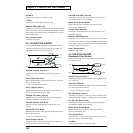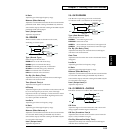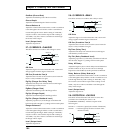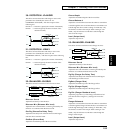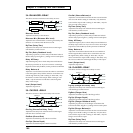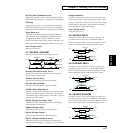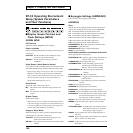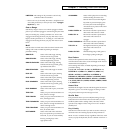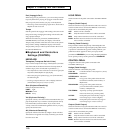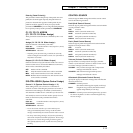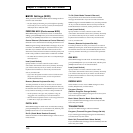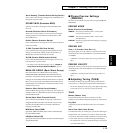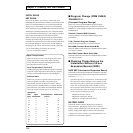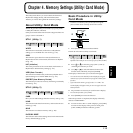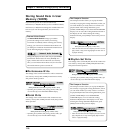
109
Chapter 3. Creating Your Own Sounds
Chapter 3
LIMITLESS: The settings of all parameters can be freely
combined without restriction.
* Choices can be set for the Motif, Beat Pattern, Shuffle Rate and
Accent Rate parameters for each style. Refer to the “Arpeggio
Style List” (p. 182).
Octave Range
Sets the key range in octaves over which arpeggio will take
place. If you want the arpeggio to sound using only the notes
that you actually play, set this parameter to 0. To have the
arpeggio sound using the notes you play and notes 1 octave
higher, set this parameter to +1. A setting of -1 will make the
arpeggio sound using the notes you play and notes l octave
lower.
Motif
Sets the order in which notes of the chord will sound. Some
settings will not be available depending on the Style
parameter setting.
SINGLE UP: Notes will sound singly, starting
from the lowest key pressed.
SINGLE DOWN: Notes will sound singly, starting
from the highest key pressed.
SINGLE UP&DOWN: Notes will sound singly, starting
from the lowest key pressed, going
up and then back down.
SINGLE RANDOM: Notes will sound singly in random
order.
DUAL UP: Notes will sound in pairs, starting
from the lowest key pressed.
DUAL DOWN: Notes will sound in pairs, starting
from the highest key pressed.
DUAL UP&DOWN: Notes will sound in pairs, starting
from the lowest key pressed, going
up and then back down.
DUAL RANDOM: Notes will sound in pairs, in random
order.
TRIPLE UP: Notes you press will sound three at a
time, from low to high.
TRIPLE DOWN: Notes you press will sound three at a
time, from high to low.
TRIPLE UP&DOWN: Notes you press will sound three at a
time, from low to high and then back
down from high to low.
TRIPLE RANDOM: Notes you press will sound three at a
time, in random order.
NOTE ORDER: Notes will sound in the order that
they were pressed. Up to 32 notes can
be stored, so you can create melody
lines by pressing keys in the
appropriate order.
GLISSANDO: Notes will be played in an ascending
and descending chromatic scale
between the lowest and the highest
keys that are pressed. Simply press
two notes, the lowest and highest.
CHORD: All notes that are pressed will sound
simultaneously.
BASS+CHORD1–5: The lowest note that is pressed and
other notes will sound as a chord.
BASS+UP1–8: The lowest note that is pressed and
other notes will sound as an
arpeggio.
BASS+RANDOM1–3: The lowest note that is pressed and
other notes will sound randomly.
TOP+UP1–6: The highest note that is pressed and
other notes will sound as an
arpeggio.
BASS+UP+TOP: Simulated fingering of folk guitar’s
three-finger picking technique.
Beat Pattern
Select the beat pattern from the choices below. This setting
will affect the location of the accent and length of the notes to
determine the beat (rhythm).
Some settings will not be available depending on the Style
parameter setting.
1/4, 1/6, 1/8, 1/12, 1/16 1–3, 1/32 1–3, PORTA-A 01–11,
PORTA-B 01–15, SEQ-A 1–7, SEQ-B 1–5, SEQ-C 1–2,
SEQ-D 1–8, ECHO 1–3, MUTE 01–16, STRUM1–8,
REGGAE1–2, REFRAIN1–2, PERC1–4, WALKBS, HARP,
BOUND, RANDOM, BOSSA NOVA, SALSA 1–4, MAMBO
1–2, CLAVE, REV CLA, GUIRO, AGOGO, SAMBA, TANGO
1–4, HOUSE 1–2
Accent Rate
Modifies the strength of accents and the length of the notes to
adjust the “groove” feel of the arpeggio. A setting of 100%
will produce the most pronounced groove feel.
Shuffle Rate
This parameter allows you to modify the timing of an up-
beat between two down-notes next to each other, to create
shuffle rhythms. With a setting of 50%, the notes will be
spaced evenly. Higher values will give more of a “dotted”
(shuffle) feel.
Key Velocity
Sets the force of the chord. If you wish to use the velocity at
which the notes are actually played, set this parameter to
REAL. To use a constant velocity regardless of the force with
which you play the keyboard, choose a desired value from 1–
127.




